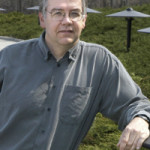The Exascale Computing Project (ECP) has selected its fifth Co-Design Center to focus on Graph Analytics — combinatorial (graph) kernels that play a crucial enabling role in many data analytic computing application areas as well as several ECP applications. Initially, the work will be a partnership among PNNL, Lawrence Berkeley National Laboratory, Sandia National Laboratories, and Purdue University.
Parallel Multiway Methods for Compression of Massive Data and Other Applications
Tamara Kolda from Sandia gave this Invited Talk at SC16. “Scientists are drowning in data. The scientific data produced by high-fidelity simulations and high-precision experiments are far too massive to store. For instance, a modest simulation on a 3D grid with 500 grid points per dimension, tracking 100 variables for 100 time steps yields 5TB of data. Working with this massive data is unwieldy and it may not be retained for future analysis or comparison. Data compression is a necessity, but there are surprisingly few options available for scientific data.”
Asetek Lands Nine Installations on the Green500
“As seen at installations included on both the Green500 and Top500 lists, Asetek’s distributed liquid cooling architecture enables cluster energy efficiency in addition to sustained and un-throttled cluster performance,” said John Hamill, Vice President of WW Sales and Marketing. “Around the world, data centers are increasingly using Asetek technology for High Performance Computing while reducing energy costs.”
Asetek Sports Eight Installations on the TOP500 Supercomputer List
“With the accelerating trend of higher wattages and the continuing requirement of high density, the need for adaptable, cost effective, and reliable liquid cooling is accelerating among those striving to obtain TOP500 status,” said John Hamill, Vice President of WW Sales and Marketing. “This need is exactly what Asetek’s distributed cooling architecture provides.”
Sandia’s Bill Camp to Receive Seymour Cray Award
This week, IEEE announced that Dr. William Camp, Director Emeritus at Sandia National Laboratories, has been named the recipient of the 2016 IEEE Computer Society Seymour Cray Computer Engineering Award “for visionary leadership of the Red Storm project, and for decades of leadership of the HPC community.” Dr. Camp spent most of his career at NNSA’s Sandia Labs, at Cray Research and at Intel.
Minimal Metrics Releases PerfMiner Parallel Optimization Tool
This week Minimal Metrics announced an early-adopter program for PerfMiner, which uses lightweight, and pervasive performance data collection technology, automates its collection, and mines the data for key performance indicators. These indicators were developed through Minimal Metrics’ extensive experience tuning HPC and enterprise application performance, presented in an audience-specific, drill-down hierarchy that provides accountability for site productivity down to the performance of individual application threads.
The Challenges and Rewards of Stockpile Stewardship
Charles W. Nakhleh from LANL presented this talk at the 2016 DOE NNSA SSGF Annual Program Review. “This talk will explore some of the future opportunities and exciting scientific and technological challenges in the National Nuclear Security Administration Stockpile Stewardship Program. The program’s objective is to ensure that the nation’s nuclear deterrent remains safe, secure and effective. Meeting that objective requires sustained excellence in a variety of scientific and engineering disciplines and has led to remarkable advances in theory, experiment and simulation.”
Saving Water with Sandia’s New Datacenter Cooling Technology
Engineers at Sandia are developing new datacenter cooling technologies that could save millions of gallons of water nationwide.
Paul Messina Presents: A Path to Capable Exascale Computing
Paul Messina presented this talk at the 2016 Argonne Training Program on Extreme-Scale Computing. “The President’s NSCI initiative calls for the development of Exascale computing capabilities. The U.S. Department of Energy has been charged with carrying out that role in an initiative called the Exascale Computing Project (ECP). Messina has been tapped to lead the project, heading a team with representation from the six major participating DOE national laboratories: Argonne, Los Alamos, Lawrence Berkeley, Lawrence Livermore, Oak Ridge and Sandia. The project program office is located at Oak Ridge.
Disruptive Opportunities and a Path to Exascale: A Conversation with HPC Visionary Alan Gara of Intel
“We want to encourage and support that collaborative behavior in whatever way we can, because there are a multitude of problems in government agencies and commercial entities that seem to have high performance computing solutions. Think of bringing together the tremendous computational expertise you find from the DOE labs with the problems that someone like the National Institutes of Health is trying to solve. You couple those two together and you really can create something amazing that will affect all our lives. We want to broaden their exposure to the possibilities of HPC and help that along. It’s important, and it will allow all of us in HPC to more broadly impact the world with the large systems as well as the more moderate-scale systems.”












